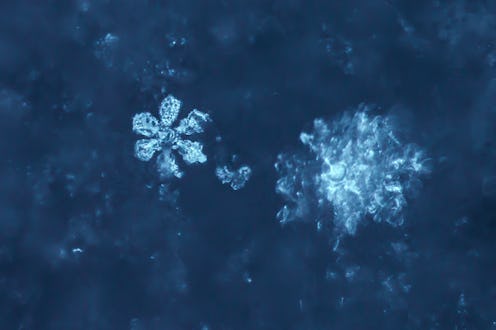
If you're currently living on the East Coast and just endured Winter Storm Jonas, you've recently been in the presence of thousands and thousands of little snowflakes. Not only that, but each one of those snowflakes is just as unique as all the different paper cutouts of them you learned to make in elementary school. But how do snowflakes form, anyway? And is it true that no two snowflakes are alike? Well, good news: The American Chemical Society answered these two burning questions in a new episode of their Reactions series, courtesy of expert information from crystallographers — that is, people who study atomic and molecular structures. The chemistry of snowflakes: Cool science, or best science? I'm going to go with best on this one.
Of course, it's not possible to confirm whether or not two snowflakes are alike by just checking them out and comparing them with every snowflake that ever has and ever will exist; however, scientists hypothesize with a high level of certainty that the chances of two snowflakes ever being the same are so low that the number can basically be rounded down to zero. While it's true that at the end of a blizzard, all snow looks exactly the same to the naked eye (and that, by roughly the third day following a winter storm, all snow looks like dirty, frothy tar), there's something to be said for the beauty and individuality of the formation of the snowflake.
Let's take a look at exactly how each snowflake is formed and why they're all so different from one another, according to the American Chemical Society. Scroll down to watch the full video!
1. Snowflakes have humble beginnings — they start as dust.
While all snowflakes end up looking wildly different, they all start as the same thing: A dust particle floating through the air. What makes the dust go from drab to fab? When water vapor finds its way to a dust grain, the combination turns into ice.
2. After more ice formation, the ice prism forms six arms.
This happens because water molecules bond into a hexagonal network. Further shape is added to the six arms when the temperature cools to nine degrees Fahrenheit, which causes the ends of the snowflake's arms to narrow even further.
3. As the snowflake falls, each layer of air gives it a different shape.
As the snowflake falls and each layer of air around it heats and cools, the snowflake will grow and change in different ways. The formation of a snowflake at cool five degree air followed by warmer nine degree air can be wildly different in another place or time when the flake goes through four degree air versus 12 degree air. Though the numbers aren't wildly different, the resulting shape is. This is ultimately why it's so unlikely that two snowflakes will appear exactly the same.
4. Scientists classify snowflakes based on their arrangements of atoms.
In the 1930s, crystallographers determined that there were only 21 different types of snowflakes, but as time went on, it became apparent that there were much more than that. By 2013, there were 121 official snowflake classifications. Neat, right?
To learn more about these tiny little specs of dust that cause so much panic, chaos, and joy down on Earth, watch the full episode of Reactions below.
Images: Anadolu Agency/Anadolu Agency/Getty Images; Reactions/YouTube (4)